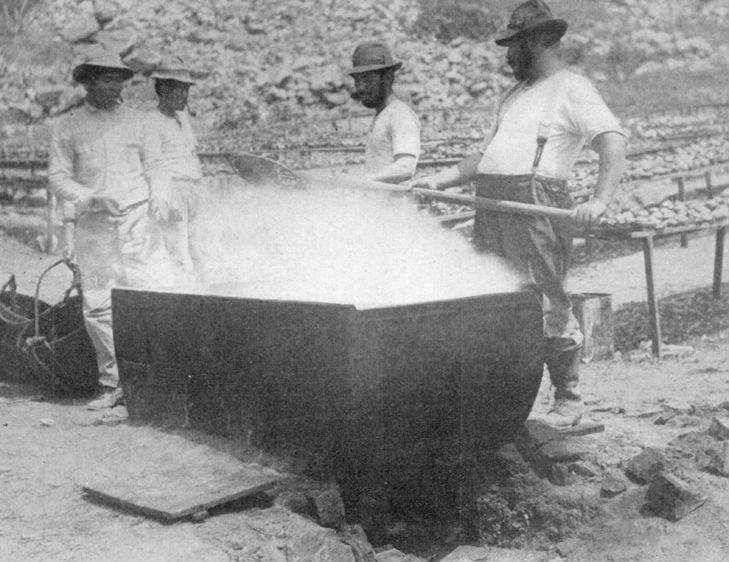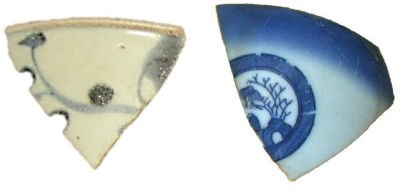Last updated: July 15, 2024
Article
A Short-Lived Livelihood: Chinese and Japanese Abalone Fishermen

The five islands of Channel Islands National Park experienced century after century of transformation. Human remains excavated on Santa Rosa Island in 1959 show there has been a human presence in the island chain for over 13,000 years. Yet abalone, a marine snail that has increasingly been the subject of archeological interest in the archipelago, may be the richest clue to its recent multiethnic industrial history.
The seafaring Chumash, whose name derives from Michumash, meaning “makers of shell bead money,” thrived on the Channel Islands’ available marine life long before European contact. Colorful abalone shells were important as adornment and items to be exchanged with mainland peoples.
Spanish colonization in the late 1700s introduced both diseases and Catholic missions to the islands, which disrupted Chumash lifeways. By the 1820s, the last of the Island Chumash—the major consumers of adult abalones—were removed to the mainland. In their absence, abalone populations exploded, though their abundance would be fleeting.

A New Taste for Abalone
Chinese immigrants streamed to the western US for the promise of gold, but discriminatory laws soon excluded them from the Gold Rush economy. Instead, Chinese individuals relied on their agricultural skills to dominate a rich but untapped coastal resource: abalone.Black abalone, an intertidal species that could be harvested on foot, made for easy profit. Fishermen would pry the shellfish off rocks before the meat was boiled, dried, and shipped to China, San Francisco, and the Hawaiian Islands. Abalone meat was a delicacy that appealed mostly to affluent Chinese communities. In the 1870s, however, demand soared when people in Europe and the eastern US began clamoring for abalone shells to make flower vases, jewelry, buttons, and other decorative items.
The earliest account of Chinese abalone collectors is from 1853 and describes a group of six men gathering in Monterey. Newspaper articles, deeds, and legal cases trace the continued prosperity of Chinese merchant ships around the Channel Islands in the mid-1880s. Chung & Company, for instance, is recorded as transporting thousands of pounds of dried abalone to China via San Francisco in 1885.
Yet the Chinese Exclusion Act of 1882 solidified anti-Chinese sentiment, as did federal laws including the Scott Act of 1888 and the Geary Act of 1892. Provisions of these acts prevented Chinese fishing vessels from leaving the US and returning, and further restrictions in 1893 threatened Chinese fishermen’s residency in America. Within the next decade, their participation in the abalone industry was quickly curtailed.
New Monopolies, Similar Problems
Japanese hardhat divers filled the vacancies left by the Chinese community. Japanese workers succeeded by implementing new methods, like collecting black abalone as well as subtidal species, but they were also aided by the very policies that disadvantaged Chinese fishermen. In 1900, California counties passed ordinances that made it illegal to gather abalones from less than twenty feet of water, which benefitted Japanese divers trained to hold their breath for long periods of time.Their work, however, only grew more difficult. In the State of California Fish and Game Commission Fish Bulletin, No. 1, 1913, zoologist Charles Lincoln Edwards describes that a standard crew consisted of a diver and his six assistants, and the team worked in water from twenty to sixty-five feet deep in four-hour shifts. Local newspapers document at least several Chinese and Japanese fishermen who drowned in the process. Others were arrested for violating regulations.

Dispelling Myths
Although Chinese and Japanese fishermen generally engaged in different periods of the abalone industry, their practices overlap in the archeological record.In 2006, archeologists recovered over 350 historical artifacts from Point Bennett on the far western tip of San Miguel Island. Food shipping containers and tableware such as a “Double Happiness” bowl, a design generally found at sites that predate 1870, indicate traditional Chinese foods like pickled vegetables and soy sauce were imported to the camp. Another distinctive item is a medium-sized bowl produced in Japan during the Meiji period of the late 1800s to early 1900s. The bowl likely belonged to Japanese divers who reused Chinese campsites in the decades after their abandonment.
Before excavations in 2007, abalone middens tended not to draw archeologists’ attention, even though they are directly endangered by coastal erosion. The piles of discarded black abalone shells suggest Chinese foraging camps were relatively short-term and highly specialized.


Archeologists also excavated many artifacts at the campsites, including Chinese and Japanese ceramic sherds, glass bottles, and personal items such as carved sea lion teeth, buttons, smoking pipes, and opium boxes. Some of these artifacts are diagnostic in that they help archeologists narrow down when the sites were occupied. For instance, it is likely that this blue-and-white Japanese sherd was brought to the islands after the late 1800’s. The fact that it was found on an earlier Chinese campsite is evidence of how these camp areas were reused through time.
Taken together, these artifacts and features help understand how Chinese and Japanese fishermen lived and worked every day on the Channel Islands. Hearths, drying slabs, and abalone shell scatters are direct remnants of a once-thriving industry, while lost buttons, broken pipes, and scattered ceramic sherds are reminders of the individuals who made it possible.
By giving these sites their due attention, archeology unburies a once-thriving industry and remembers the Chinese and Japanese individuals whose entrepreneurship, though often misinterpreted in the historical record, made it possible.
Sources
Bentz, Linda. “Chinese Fishermen of Santa Barbara and Santa Rosa Island.” Chinese America: History & Perspectives, Jan. 1997, p. 129.
Braje, Todd J., et al. “Fishing from Past to Present: Continuity and Resilience of Red Abalone Fisheries on the Channel Islands, California.” Ecological Applications, vol. 19, no. 4, 2009, pp. 906–19.
Braje, Todd J., Julia G. Costello, Jon M. Erlandson, and Robert DeLong. Of Seals, Sea Lions, and Abalone: The Archaeology of an Historical Multiethnic Base Camp on San Miguel Island, California. Historical Archaeology, vol. 48, no. 2, pp 122-142.
Edwards, Charles Lincoln. “The Abalone Industry in California.” Fish Bulletin, no. 1, 1913, pp. 5-15.
National Park Service. Chinese Abalone Fishermen.
National Park Service. Chumash on Santa Rosa Island.
National Park Service. The Archeology of Abalones: Chinese and Japanese Fishing Camps in Channel Islands National Park.
National Park Service. The History of Chinese Abalone Fishing in California.
